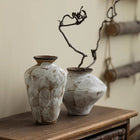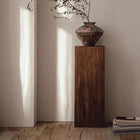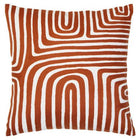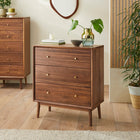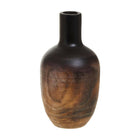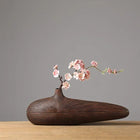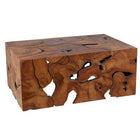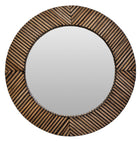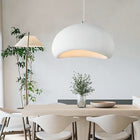Transforming Spaces: Unveiling the Power of Japan prints and Feng Shui
by Mae Osz on Nov 17, 2023
Have you ever stepped into a room and immediately felt a sense of tranquillity and harmony? It could be the combination of exquisite Japan prints and careful furniture arrangement according to the principles of Feng Shui. Japanese wall art, known for its elegance and simplicity can transform spaces and create a serene ambience. Combined with the ancient practice of Feng Shui, which seeks to balance the energy flow within a space, the power of Japanese wall art becomes even more profound.
Table of Contents:
Introduction
1. Feng Shui and Japan prints
2. Colour and energy
3. Symbolic imagery in Japan wall art prints
4. The Essence of Japanese Wall Art
5. Exploring the Principles of Feng Shui
6. Harmony in Home Decor
7. Enhancing Peace and Tranquility
8. Bringing Positive Energy into Your Space
Conclusion
In Japanese culture, wall art decor holds a special significance. It not only serves as a means of aesthetic expression but also as a reflection of the natural world and the harmony of the universe. Traditional Japanese wall art often features images of nature, such as cherry blossoms, bamboo, or serene landscapes, and these carefully selected symbols profoundly impact a room's energy.

1. Feng Shui and Japan prints
On the other hand, the principles of Feng Shui provide a holistic approach to creating a harmonious living space. Originating from ancient China, Feng Shui is grounded in the belief that objects' arrangement and energy flow within a space can significantly influence our well-being and success. By incorporating the correct elements and principles into our living environment, we can harness positive energy and create a space that supports our physical, emotional, and spiritual well-being.
When Japan prints and Feng Shui principles are combined, the transformative power of these practices becomes even more evident. The serene and nature-inspired images found in Japanese art prints have a calming effect on the mind and spirit, creating an atmosphere of tranquillity and serenity. When you place these artworks strategically following Feng Shui principles, such as positioning them in areas that promote balance and harmony, the energy of a space flows, creating a harmonious and welcoming environment.

2. Colour and energy
One fundamental principle of Feng Shui is using colour to influence the energy flow within a space. Japanese wall art often incorporates a limited colour palette, with soft and natural tones that evoke a sense of calm and serenity. Earthy tones such as greens, blues, and browns are commonly used to promote relaxation and a connection with nature. By choosing Japanese art prints with these calming colours and placing it in areas that require a balance of energy, such as bedrooms or meditation spaces, the room's energy flows in harmony, allowing for a deeper sense of peace and well-being.
Another important aspect of both Japanese wall art and Feng Shui is the concept of balance and simplicity. Japanese wall art often features minimalist designs with clean lines and open spaces. This simplicity creates a sense of calm and allows for a more focused and serene atmosphere. Similarly, Feng Shui principles emphasise decluttering and creating space for energy to flow freely. Combining these practices can transform a space into a sanctuary of tranquillity, promoting clarity of mind and a sense of renewal.
3. Symbolic imagery in Japan prints
For example, cherry blossoms are commonly depicted in Japan prints. They symbolise beauty, transience, and the fleeting nature of life. Incorporating such imagery into a living space can serve as a reminder to appreciate the present moment and find beauty in impermanence. By selecting wall art that resonates with personal values and beliefs, individuals can indeed create a space that promotes harmony and reflects their unique identity and aspirations.
4. The Essence of Japan prints
Japan prints are certainly a reflection of the rich cultural heritage and artistic traditions of Japan. It embodies the essence of simplicity, harmony, and serenity deeply rooted in the Japanese way of life. From traditional paintings to contemporary prints, Japanese wall art holds a special place in art enthusiast's and interior designers' hearts.
Aesthetics and Symbolism
One of the distinguishing characteristics of Japanese wall art is its emphasis on aesthetics. Every brushstroke, colour choice, and composition is indeed carefully thought out to create a visually pleasing and balanced composition. The use of negative space, known as "ma," is prominent in Japanese art, allowing the viewer to appreciate the beauty of emptiness.
Symbolism plays a significant role in Japanese wall art. Many artworks are infused with powerful symbols that hold special meaning in Japanese culture. For example, the cherry blossom represents the transient nature of life, while the crane symbolises longevity and good fortune. These symbols add depth and resonance to the artwork, creating a deeper connection between the viewer and the piece.
Nature and Seasons
In addition, Nature holds a central place in Japanese wall art. Artists draw inspiration from the natural world, capturing its beauty and essence in their artwork. Paintings of landscapes, flowers, birds, and animals are commonly found in Japanese wall art. The depiction of seasons, with their distinctive colours and atmospheres, is a recurring theme, symbolising the transient nature of existence and the appreciation of impermanence.
Traditional Techniques
Traditional Japanese wall art often employs traditional techniques passed down through generations. Sumi-e, or ink wash painting, is one such technique that uses black ink and brush strokes to create minimalist yet powerful images.

Zen and Spirituality
Japanese wall art often reflects the influence of Zen Buddhism and spirituality. Zen's minimalist and serene qualities are embodied in the artwork, promoting a sense of calm and tranquillity. The use of negative space and the emphasis on capturing the subject's essence rather than its meticulous details reflect the Zen concept of mindfulness and living in the present moment.

Contemporary Adaptations
While traditional Japanese wall art continues to be highly valued, contemporary adaptations are emerging to the evolving tastes and preferences of the modern world. Artists blend traditional techniques with contemporary themes and styles, creating a fusion of old and new. These adaptations often incorporate elements of nature, symbolism, and spirituality, reflecting Japanese wall art's timeless beauty and relevance.
In conclusion, Japanese wall art encapsulates the essence of Japanese culture and aesthetics. Its emphasis on simplicity, harmony, and symbolism creates a serene and inviting atmosphere in any space. Whether it is traditional artwork or contemporary adaptations, Japanese wall art continues to enchant and inspire art enthusiasts, interior designers, and those seeking tranquillity in their surroundings.
5. Exploring the Principles of Feng Shui
Feng Shui is indeed an ancient Chinese practice that focuses on arranging and placing objects in a space to achieve harmony, balance, and positive energy flow. This principle can be applied to various aspects of life, including home design and décor. By incorporating the principles of Feng Shui into your space, you can certainly create an environment that promotes peace, prosperity, and well-being.
One of the key elements of Feng Shui is the concept of yin and yang, which represents opposing yet complementary forces. Balancing these forces within a space is believed to bring harmony and also positive energy. In Japanese wall art, incorporating yin and yang elements can be achieved through contrasting colours, shapes, and textures.

Colours play a significant role in Feng Shui, as they are believed to have specific energetic qualities. In Japanese wall art, colours such as red, representing passion and vitality, or blue, symbolising tranquillity and relaxation, can be strategically employed to create the desired atmosphere. It is essential to choose colours that align with the purpose and function of the space to enhance the overall energy flow.
Shapes also have symbolic meanings in Feng Shui. In Japanese wall art, you may find representations of circular shapes representing unity and harmony or square shapes symbolising stability and balance. Incorporating these shapes into your space can enhance the energetic flow and create a sense of equilibrium.
When considering the principles of Feng Shui in relation to Japanese wall art, it is essential to remember that the ultimate goal is to create a space that supports your well-being and aligns with your intentions.
6. Harmony in Home Decor
Achieving harmony in home decor is fundamental in Japanese wall art and Feng Shui. Both philosophies emphasise creating a balanced, peaceful environment that promotes positive energy and well-being. Incorporating these principles into your home decor allows you to transform your living space into a harmonious sanctuary.
Japanese Wall Art: A Source of Balance and Serenity
Japanese wall art has long been renowned for its ability to create a sense of tranquillity and balance in a space. Traditional Japanese art forms such as Ikebana (the art of flower arrangement), calligraphy, and woodblock prints all contribute to the serene atmosphere.
One key aspect of Japanese wall art is its emphasis on simplicity and minimalism. Using clean lines, muted colours, and natural materials helps create a calming and uncluttered space. Traditional Japanese themes such as nature, landscapes, and Zen gardens are often depicted in these artworks, invoking a sense of peace and harmony with the natural world.

When choosing Japan wall art prints for your home, choose pieces that align with your desired atmosphere. Incorporate artwork that complements your space's overall design aesthetic and colour scheme. Whether a delicate cherry blossom painting or a serene landscape print, these art pieces can act as focal points and create a sense of balance within your home.
Feng Shui: Balancing Energy in Your Living Space
Feng Shui, a Chinese philosophy of arranging furniture and objects to promote positive energy flow, can indeed be seamlessly integrated with Japanese wall art to enhance harmony in your home. This ancient practice seeks to balance the yin and yang energies, which are believed to influence the well-being and harmony of individuals within a space.
In Feng Shui, placing furniture, objects, and artwork is essential to create a harmonious environment. Japanese wall art can be crucial in this arrangement, as it certainly helps create a visually pleasing and balanced atmosphere. Artwork with soft and flowing lines and natural and calming themes can contribute to positive energy flow.
According to Feng Shui principles, consider incorporating Japanese wall art in specific home areas. For example, in the living room, place a large landscape painting on the north or east wall to foster a sense of tranquillity and balance. In the bedroom, choose artwork that promotes relaxation and a restful atmosphere, such as serene water scenes or gentle floral designs.
Creating Your Harmonious Haven
To achieve harmony in home decor, incorporate elements of Japan wall art prints and Feng Shui principles thoughtfully:
- Emphasise simplicity and minimalism in your overall design aesthetic, using clean lines, muted colours, and natural materials.
- Choose Japanese wall art that aligns with your desired atmosphere, incorporating pieces that complement your existing colour scheme and overall design.
- Apply Feng Shui principles in placing furniture, objects, and artwork, ensuring a balanced energy flow throughout your home.
- Consider the specific themes and motifs in Japanese wall art to create a harmonious environment in each area of your home.
In addition, By combining the beauty of Japanese wall art with the principles of Feng Shui, you can transform your living space into a harmonious haven that nurtures balance, tranquillity, and positive energy.

7. Enhancing Peace and Tranquility
Japanese wall art, combined with Feng shui principles, can certainly transform spaces into havens of peace and tranquillity. By carefully selecting and arranging artwork, you can create a harmonious atmosphere that promotes a sense of calm and balance.
1. Nature and Serenity
One of the fundamental elements of Japanese wall art is its close connection to nature. Whether it's a painting of a serene landscape, a delicately crafted bamboo screen, or a simple cherry blossom print, these artworks bring the beauty of the natural world indoors. The presence of nature-inspired art can create a soothing and tranquil environment, reducing stress and promoting a sense of serenity.
2. Color and Balance
The colours used in Japanese wall art create a peaceful ambience. Traditional Japanese art often features a muted colour palette, characterised by subtle earth tones, soft pastels, and harmonious combinations. These colours help to create a sense of balance and tranquillity within a space.
When selecting artwork, consider the colour scheme of your room and choose pieces that complement or enhance it. For example, if your walls are painted in neutral tones, opting for art with soft blues or greens can improve the calming effect. Conversely, if your room is already vibrant, consider choosing art with more muted colours to balance the energy.

3. Symmetry and Placement
Feng Shui principles emphasise the importance of proper placement and symmetry in creating a harmonious environment. Consider the size and shape of the space you intend to decorate when choosing your Japanese wall art. Larger, bold pieces can anchor a room and draw attention. At the same time, You can strategically place smaller, more delicate artworks to create a sense of balance.
Balance is vital when arranging artwork. If you have a large piece on one side of the room, balance it with a smaller piece or a group of smaller pieces on the opposite side. This helps to create a visually pleasing and harmonious atmosphere.
4. Calming Themes and Imagery
Japanese wall art often incorporates calming themes and imagery like the ocean, mountains, or Zen gardens. These motifs are visually appealing and evoke a sense of peace and tranquillity. By incorporating such elements into your decor, you certainly create a space that encourages relaxation and contemplation.
Be mindful of the symbols and representations used in Japanese art. For example, koi fish symbolise good luck and perseverance, while cranes represent longevity and wisdom. By understanding the symbolism behind the artwork, you can infuse your space with more profound meaning and promote a sense of tranquillity.
5. Minimalism and Simplicity
The principles of minimalism and simplicity are deeply rooted in Japanese aesthetics. Japanese wall art often features clean lines, uncluttered compositions, and a focus on the subject's essence. This minimalist approach creates a sense of calm and eliminates visual distractions.
When selecting artwork, opt for pieces that have a simple and uncluttered design. Only artworks that are appropriately busy or intricate, as they can disrupt the peaceful atmosphere you are trying to create. Embrace minimalism and let the art speak for itself.
Incorporating Japanese wall art and Feng shui principles into your home or workspace can profoundly impact your well-being. Creating a space that promotes peace and tranquillity invites a sense of harmony and balance into your life. So, surround yourself with Japanese art's beauty and enjoy its transformative power.

8. Bringing Positive Energy into Your Space
Creating a harmonious and positive environment is essential to achieving balance and well-being in your space. Incorporating Japanese wall art and applying Feng Shui principles can effectively bring positive energy into your home or office. Here, we explore how these elements work together to transform your space.
Curious to unravel the ancient wisdom and principles that underlie the art of Feng Shui? Dive into the origins and core of this traditional practice, where the arrangement of spaces harmonises with the natural flow of energy, or "Qi." Click here to explore the profound philosophy behind Feng Shui, unlocking the secrets to creating balanced and positive environments that promote well-being, prosperity, and a sense of tranquility. Discover the timeless insights that Feng Shui offers for achieving harmony in your living spaces.









